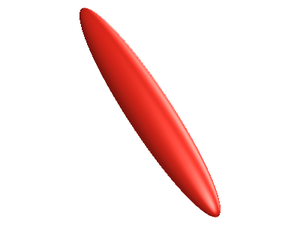Hard ellipsoid model: Difference between revisions
Jump to navigation
Jump to search
Carl McBride (talk | contribs) No edit summary |
Carl McBride (talk | contribs) No edit summary |
||
| Line 7: | Line 7: | ||
where <math>a</math>, <math>b </math> and <math>c</math> define the lengths of the | where <math>a</math>, <math>b </math> and <math>c</math> define the lengths of the | ||
axis. | axis. | ||
==Overlap algorithm== | |||
The most widely used overlap algorithm is that of Perram and Wertheim: | |||
*[http://dx.doi.org/:10.1016/0021-9991(85)90171-8 John W. Perram and M. S. Wertheim "Statistical mechanics of hard ellipsoids. I. Overlap algorithm and the contact function", Journal of Computational Physics '''58''' pp. 409-416 (1985)] | |||
==See also== | ==See also== | ||
*[[Hard ellipsoid equation of state]] | *[[Hard ellipsoid equation of state]] | ||
Revision as of 11:49, 21 May 2007

Interaction Potential
The general ellipsoid, also called a triaxial ellipsoid, is a quadratic surface which is given in Cartesian coordinates by
where , and define the lengths of the axis.
Overlap algorithm
The most widely used overlap algorithm is that of Perram and Wertheim:



